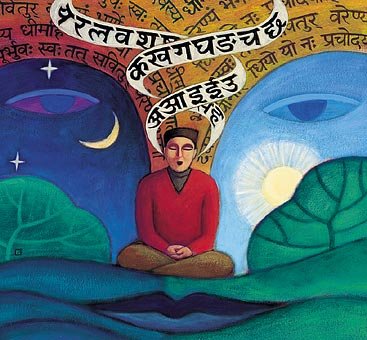(This is the first of a two-part article on Dr. P. Ramanujan’s work on Sanskrit and computers)
In the late 1920s, Ghanapathi Parankusachar Swami won a prize in Sanskrit. When asked whether he wanted the prize of Rs 3,000 in cash or kind, he asked for books! Thus he acquired a wonderful library. This enabled his son Ramanujan to pore over the books every day.
Ramanujan spent seven years putting the contents of the Sastras into a database. He culled 30,000 sutras from all the Sastras, classified the different aspects of the Sastras, and gave his compendium the name, Sakala Sastra Sutra Kosa.
When a retired professor of Physics from IIT Madras, who became a sanyasi after being initiated by Sringeri Pontiff, Paramananda Bharati, organised a conference in Delhi on Sanskrit and Computers, Ramanujan told him about the kosa and was asked to present a paper at the conference.
The paper was on using computers for Sanskrit. Many IIT professors were present and what caught their attention was that Ramanujan had come up with a flow chart in Sanskrit, and a programme for the generation of nouns. The then President of India, Dr. Shankar Dayal Sharma, was so impressed that he suggested that Dr. Bhatkar- founder director of Centre for Development of Advanced Computing (C-DAC) – make use of Ramanujan’s services. In 1990, Ramanujan joined C-DAC, Pune. While in Pune, Ramanujan developed DESIKA, a comprehensive package for generating and analysing Sanskrit words.
What does DESIKA do? “Given a Sanskrit word, it gives you the hidden meanings, the meanings with which it is packed. Key in a word and DESIKA gives you the noun attributes like paradigm, ending type, noun base, number and case, and similarly for verbs.”
When Ramanujan joined C-DAC, their ISCII standard was in the testing stage. Ramanujan wrote the Vedic part of the standard.
Around this time, a question was raised in Parliament about what Indian scientists were doing in the field of Computers and Sanskrit. Ramanujan was asked to make a presentation in Parliament. He presented DESIKA, and later gave a demo in the Parliament annexe. The then Prime Minister P.V. Narasimha Rao, who held the Science and Technology portfolio, attended the demo and was amazed at the simplicity of DESIKA.
Ramanujan made a second presentation in Parliament in 1993. The question now was about how to handle differences between Vedic and classical Sanskrit. Ramanujan replied that this would pose no problems, and showed a 73 by 26 matrix, which he had prepared (73 individual characters in the Vedic part and 26 parameters). For every Vedic syllable, there are three components- consonant, vowel and accent, and each syllable has 26 parameters, which define it fully.
In 1994, C-DAC began work on Vedic fonts and today, all the Vedas have been rendered machine readable. Searchable, analysable Sastraic contents, Itihasas, Puranas, Divya Prabandham are all now available too, with value added features such as retrieval as word, stem, compounds, including Boolean search. You can use the same keyboard layout for any script.
Ramanujan entrusted to students of Veda Pathasalas, the task of typing out old texts. “One lakh pages have been typed, and 600 texts covered. But the task of annotation still remains, because there are not enough knowledgeable people to do the job.”
Aren’t people who study for many years in pathasalas competent to do this? “Not necessarily. Most of the pathasalas concentrate on rote learning. I feel we can dilute the memorising part and concentrate on analysis. We need to make this kind of study monetarily attractive as well.”
Ramanujan was the Principal Investigator for the TARKSHYA (Technology for Analysis of Rare Knowledge Systems for Harmonious Youth Advancement) project, which envisages providing Sanskrit institutions across the country with high speed connectivity, for promoting heritage computing activities. Content has also been developed for online study. Three courses have been designed: Vedic processing, Sastras and manuscript processing. “We have video lectures by 40 scholars. Students can access the lectures through their mobiles. If a student wants to search something later, he can do so, for a verbatim transcript is available.”
For manuscript processing, a computer application program, called Pandu-lipi Samshodaka has been developed by C-DAC, which has browse, search, index, analyse and hyperlinking features.
Ramanujan takes me round his library, which has many rare manuscripts, some of them more than 400 years old. They have all been digitised. He feels students must seek out old manuscripts, for who knows what treasures lie hidden in them?
How can we tweak education for students of traditional learning? “A student of Indian logic should study Western logic too. A student of vyakarana must study modern theories of linguistics. Study should be interdisciplinary- mathematics in ancient Sanskrit texts and in modern texts; transdisciplinary- that is different areas within Sanskrit such as vyakarana, mimamsa, nyaya; multi disciplinary- a student of ayurveda could perhaps study the therapeutical aspects of music.”
Helpful for scholars
Ramanujan has a website parankusa.org, in which he gives the Arsheya system for the Krishna Yajur Veda. This is a topical arrangement of contents. What is actually followed today is the Saarasvatha system, which does not have such an ordering. Giving the Arsheya system alongside the Saarasvatha ordering, has been of great help to many Sanskrit scholars.






